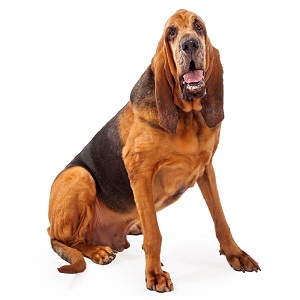Can Bloodhounds Be Guard Dogs?
Looking to own a Bloodhound puppy and need to know whether a Bloodhound can be a good watch dog or if Bloodhound Dogs are protective of their owners?
According to dog trainers, Bloodhound Dogs score  out of 5 in the scale of breeds that are considered the best guard dogs.
out of 5 in the scale of breeds that are considered the best guard dogs.
Can Bloodhounds Be A Watch Dog?
-
This dog is not recommended to be a watchdog.
Training a Bloodhound To Be a Watch Dog
A watch dog just simply informs their owner to someone approaching their house. Even though your dog isn't a police canine, most barking dogs will deter an intruder even if they aren't big. Most guard dogs also make great watch dogs, but not all watch dogs make good guard dogs.
Top 5 Best Guard Dogs
2. Cairn Terrier - Although small, the Cairn Terrier is intense. They are strong-willed, fiery little terriers that are really watchful of their surroundings and will alert their owners to any novel activity in no time. Due to this, they make outstanding watch dogs.
3. Rottweiler - The Rottweiler is a large German guard dog breed that is deeply loyal to its family but wary of strangers. However, they are not a great choice for novice dog owners.
4. German Shepherd - They are excellent guard dogs that will inform their owners of any strangers just a little too close to their homes.
5. Akita - They will quickly signal their owners to any unusual activity. They are powerful dogs that are not well-suited for the newbie owner, but are almost unparalleled in their loyalty to their owners.
What to do if you lose your Bloodhound
If your Bloodhound Dog or any other pet has gone missing and it does not have an identification tag with a phone number, you can:
1. Register your missing pet details at Pet Reunite website here.
2. Register the missing pet on the Local Lost Pets Facebook Groups Here.
3. Visit the nearby vet clinics to see if anyone has brought in your lost pet.
4. Contact the RSPCA or Visit the RSPCA Lost Pets website and complete a Lost Pet Report.
5. Visit Lost Pets Pages of Animal Pounds.
What to do if you find a lost Bloodhound
If you find a Bloodhound Dog or any other pet and it does not have an identification tag with a phone number, you can:
1. Report the found pet details at Pet Reunite website here.
2. List the missing pet on the Local Facebook Lost Pets Groups.
3. Contact the Local Council to collect the lost animal.
4. Take the animal to the local Animal Shelter near to your area.
5. Take the pet to the local Vet Clinic who normally scan the animal’s microchip and call the registered pet owner.
Laws Regarding Missing Pets
1. It is against the law to keep any animal that you find.
2. Pets are generally considered property and it is illegal to take and keep someone else’s property.
3. You must contact your local animal control unit and file a FOUND AN ANIMAL report for any dog or cat you find.
4. To reclaim your lost dog, cat or other pet from the animal shelter you must pay a release fee.
5. If your dog or cat is unregistered, you will have to register your pet before you can take it home.

